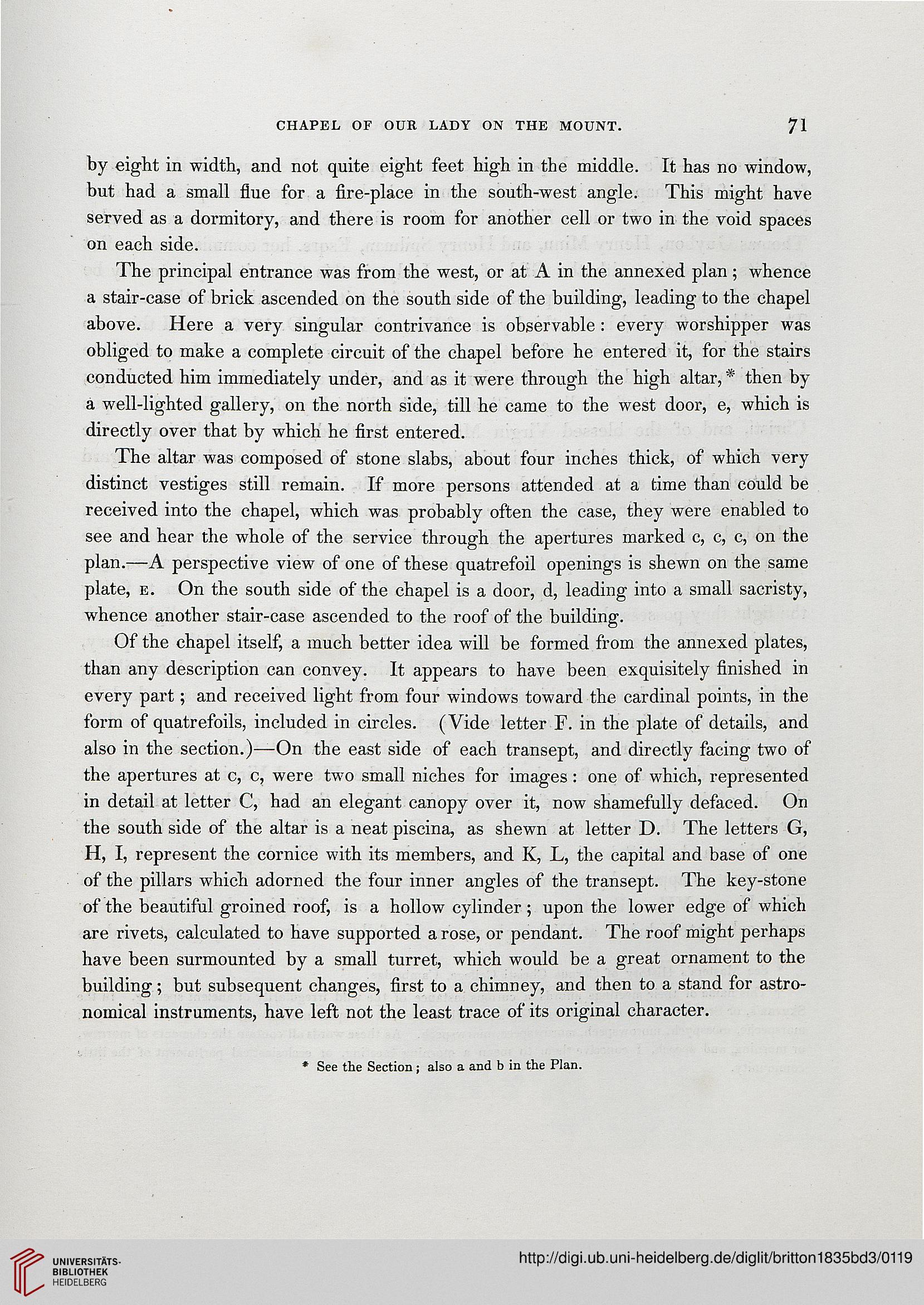chapel of ouk lady on the mount.
71
by eight in width, and not quite eight feet high in the middle. It has no window,
but had a small flue for a fire-place in the south-west angle. This might have
served as a dormitory, and there is room for another cell or two in the void spaces
on each side.
The principal entrance was from the west, or at A in the annexed plan; whence
a stair-case of brick ascended on the south side of the building, leading to the chapel
above. Here a very singular contrivance is observable : every worshipper was
obliged to make a complete circuit of the chapel before he entered it, for the stairs
conducted him immediately under, and as it were through the high altar, * then by
a well-lighted gallery, on the north side, till he came to the west door, e, which is
directly over that by which he first entered.
The altar was composed of stone slabs, about four inches thick, of which very
distinct vestiges still remain. If more persons attended at a time than could be
received into the chapel, which was probably often the case, they were enabled to
see and hear the whole of the service through the apertures marked c, c, c, on the
plan.—A perspective view of one of these quatrefoil openings is shewn on the same
plate, e. On the south side of the chapel is a door, d, leading into a small sacristy,
whence another stair-case ascended to the roof of the building.
Of the chapel itself, a much better idea will be formed from the annexed plates,
than any description can convey. It appears to have been exquisitely finished in
every part; and received light from four windows toward the cardinal points, in the
form of quatrefoils, included in circles. (Vide letter F. in the plate of details, and
also in the section.)—On the east side of each transept, and directly facing two of
the apertures at c, c, were two small niches for images : one of which, represented
in detail at letter C, had an elegant canopy over it, now shamefully defaced. On
the south side of the altar is a neat piscina, as shewn at letter D. The letters G,
H, I, represent the cornice with its members, and K, L, the capital and base of one
of the pillars which adorned the four inner angles of the transept. The key-stone
of the beautiful groined roof, is a hollow cylinder ; upon the lower edge of which
are rivets, calculated to have supported a rose, or pendant. The roof might perhaps
have been surmounted by a small turret, which would be a great ornament to the
building; but subsequent changes, first to a chimney, and then to a stand for astro-
nomical instruments, have left not the least trace of its original character.
* See the Section; also a and b in the Plan.
71
by eight in width, and not quite eight feet high in the middle. It has no window,
but had a small flue for a fire-place in the south-west angle. This might have
served as a dormitory, and there is room for another cell or two in the void spaces
on each side.
The principal entrance was from the west, or at A in the annexed plan; whence
a stair-case of brick ascended on the south side of the building, leading to the chapel
above. Here a very singular contrivance is observable : every worshipper was
obliged to make a complete circuit of the chapel before he entered it, for the stairs
conducted him immediately under, and as it were through the high altar, * then by
a well-lighted gallery, on the north side, till he came to the west door, e, which is
directly over that by which he first entered.
The altar was composed of stone slabs, about four inches thick, of which very
distinct vestiges still remain. If more persons attended at a time than could be
received into the chapel, which was probably often the case, they were enabled to
see and hear the whole of the service through the apertures marked c, c, c, on the
plan.—A perspective view of one of these quatrefoil openings is shewn on the same
plate, e. On the south side of the chapel is a door, d, leading into a small sacristy,
whence another stair-case ascended to the roof of the building.
Of the chapel itself, a much better idea will be formed from the annexed plates,
than any description can convey. It appears to have been exquisitely finished in
every part; and received light from four windows toward the cardinal points, in the
form of quatrefoils, included in circles. (Vide letter F. in the plate of details, and
also in the section.)—On the east side of each transept, and directly facing two of
the apertures at c, c, were two small niches for images : one of which, represented
in detail at letter C, had an elegant canopy over it, now shamefully defaced. On
the south side of the altar is a neat piscina, as shewn at letter D. The letters G,
H, I, represent the cornice with its members, and K, L, the capital and base of one
of the pillars which adorned the four inner angles of the transept. The key-stone
of the beautiful groined roof, is a hollow cylinder ; upon the lower edge of which
are rivets, calculated to have supported a rose, or pendant. The roof might perhaps
have been surmounted by a small turret, which would be a great ornament to the
building; but subsequent changes, first to a chimney, and then to a stand for astro-
nomical instruments, have left not the least trace of its original character.
* See the Section; also a and b in the Plan.




